 |
||
|
||
| ||
How Much Heat Can Be Channeled Away by a Heatsink and How Much – by a Fan?These coolers are massive well-built heatsinks composed of copper 0.5 mm plates. Half a kilogram of pure copper each. The plates are screwed to the massive base at the bottom. All in all, they are bright representatives of the approach to boost heatsink weight and dimensions in order to increase heat dissipation from a processor. IH-3400WFCA cooler (#1) is manufactured without a fan at all, though designers admit that users may want to install it on their own. 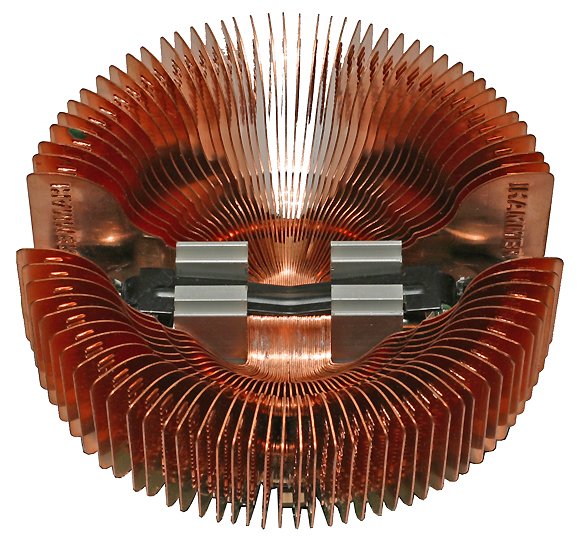 According to the official web site the cooler weighs 488 g, its dimensions: 106X106X58 mm. It is used for the following processors: AMD Athlon XP and Athlon 64 up to 3400+, Intel P4 up to 3.4 GHz. 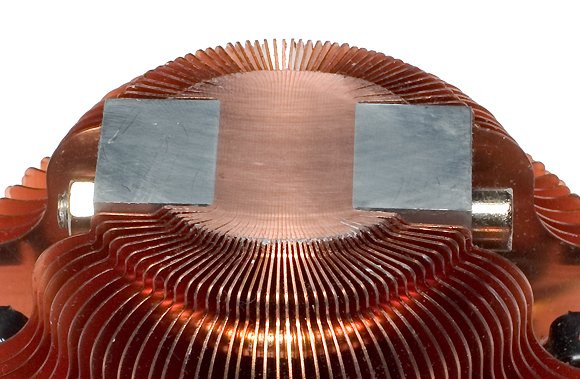 IH-3200C cooler (#2) has a smaller-diameter heatsink. The fan is installed inside the heatsink bowl. 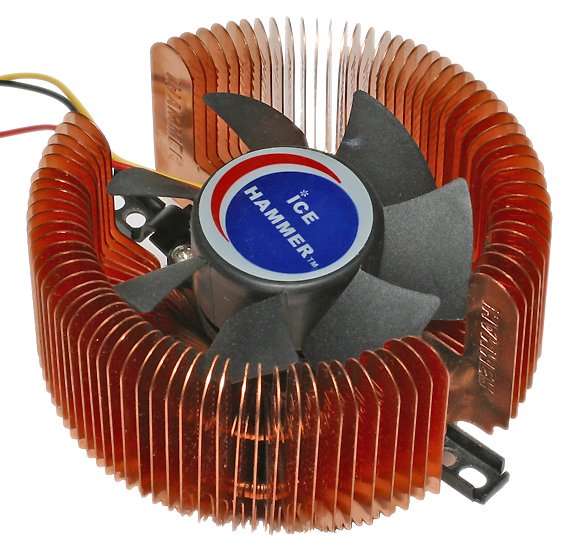 According to the official web site: dimensions – 92x92x67mm. Weight – 548 g. Rotational speed of the fan is 3000 rpm +/-10%. Noise – 32 dB. It's used for the same processors.
These devices are just crying to evaluate the effect from the heatsink and the fan separately and see how well they work together. Generally accepted methods for evaluating thermal efficiency of coolers on operating processors wouldn't do for us. They offer no ways to predict the CPU temperature with disabled fan or without a cooler at all, which wouldn't result in PC damage. That's why we decided to try another tack, which is also well known. Namely, to create a thermal testbed similar to those used for designing new coolers. Test labs with such technical capacities are mostly dismissed or closed down in our parts. That's why our testbed is still primitive and imperfect. But it helps to evaluate thermal efficiency of coolers and to take aerodynamical measurements, to begin with. Testbed design and measurement systemThe key idea of this testbed is not new – to emulate a heat flow from a real processor by using an adjustable heating element that can produce an identical heat flow. So it won't be damaged even without cooling. We used a 9x11 mm brass plate for a cooler-contact platform. A copper rod is pressed into its center, which channels the heat (100 W). We took a piece of a motherboard with Socket 7, drilled a hole, and installed the plate with the rod. The whole construction was mounted on a lab table. 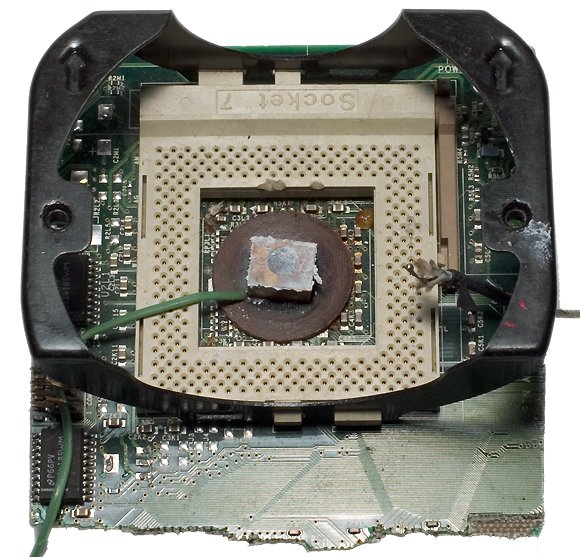 A thermocouple is installed at the back side of the platform in a 1 mm groove, it's connected to the DT-838 multimeter. The temperature it reads is the base temperature in the coming tests. The cooler is mounted like in a computer, it's pressed tight to our platform. The temperature in characteristic heatsink points is measured by another thermocouple connected to the DT-830 multimeter. It should be noted that the error of this multimeter turned out too high, about 5%. That's why we used it only to check the measurement taken by DT-838. 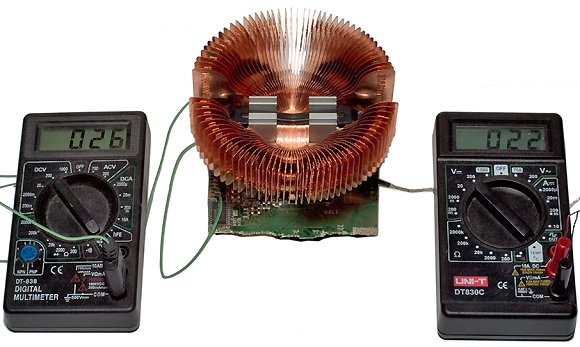 We have deliberately chosen the Cooler 2 platform temperature by 10-15°C higher compared to the readings of standard CPU sensors, to obtain a safe margin for the heat flow intensity. The tests were repeated minimum three times on several days. Deviations of measured parameters did not exceed 1.5-2%. In our aerodynamic tests of Cooler 2 to measure the air flow speed we used the DISA 55D80 hot-wire anemometer, described in detail in this article. Test results of Cooler 1At first we heated the platform without a cooler at the fixed power of the heating device. It took about 40 minutes to reach the steady state mode. The steady state mode is considered reached, when the multimeter readings vary within +/-2°C for 10 minutes. Environment temperature was 26°C, it was double-checked with a mercury thermometer. The platform temperature reached 374°C. Then we installed the heatsink on the platform using the KPT-8 thermal paste. You can see the readings on the following graph. Temperature readings. IH-3400WFCA cooler
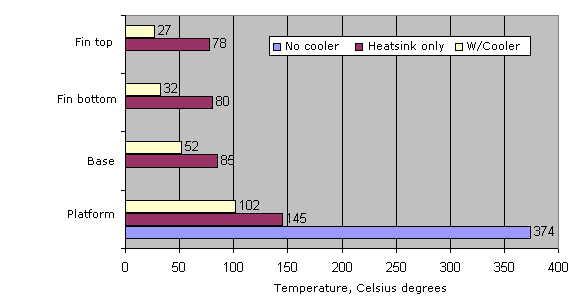 You can see that after the heatsink was installed, platform temperature dropped almost by 230°C and stopped at 145°C. By the way, if we hadn't used thermal paste, it would have been 12°C higher. Temperature of the heatsink bottom — 85°C, inside the heatsink — 89°C. Pay attention to the temperature of the vertical section of the fins. The length of this section is approximately half of the entire fin length. It's 80°C in the middle, and 77°C in the top section. The maximum circumferential difference between fin temperatures here reaches 2°C. Then we followed the timid advice from manufacturers and installed a chinese fan Glacialtech Everflow on top of the heatsink – they fit perfectly. The platform temperature dropped to 102°C. But the most interesting thing is that the temperature of the vertical fin section dropped to 27°C, that is nearly to the environment temperature. 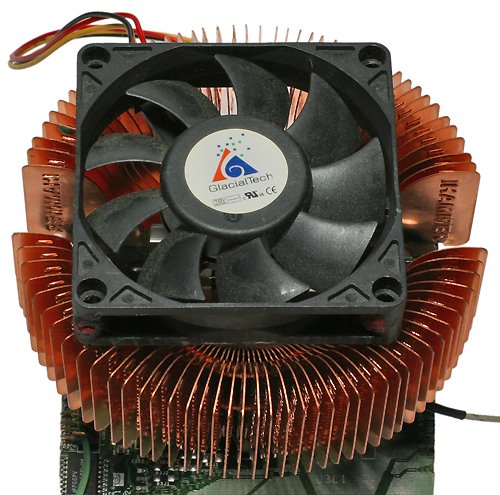 We shall analyze this phenomenon below when we test a real Cooler 2 instead of a heatsink with a fan popped on top. Test results of Cooler 2Let's do the same with Cooler 2. The environment temperature is 25°C now. By the way, its fluctuation by 1-3 degrees had no noticeable effect on the platform temperature. 10°C fluctuation should have some effect, but we didn't try to make a fridge of the room. The readings are given on Picture #2. Temperature readings. IH-3200C cooler
 You can see that the platform temperature is ditto 374°C. It's 140°C with a heatsink (the fan is just disabled). The fin temperature is 87°C at the base, 78°C in the middle of the vertical section, 77°C in the upper section. That is, it's actually a complete counterpart of Cooler 1. But when the fan is enabled, the platform temperature goes down to 87°C, which is 15°C lower that in Cooler 1. It's clear that the fan is an integral part of the heatsink and the effect is obvious. If we put the fan from the previous test and enable them together (both rotate counterclockwise), the platform temperature drops down another 5°C. But if the main fan is disabled, the temperature goes to 87°C again, no matter how many times you repeat the experiment. There is an explanation to it, lots of them, but let's not frame hypotheses so far and limit ourselves to food for thought. But the temperature of vertical edges is again practically equal to the environment temperature — 27°C. 32°C — at the base of the heatsink. Let's measure the air flow speed between the fins at the heatsink output to find out what's going on. On the next picture you can see the typical zones and air flow speed readings. The tests were carried out with a cold cooler. You can see that the largest volume of air passes through relatively small Areas 3 and 4. That's where the most heat is channeled away. The longest vertical section of fins is sort of blocked and does not take part in active heat exchange. Aerodynamic readings prove that the main heat is channeled away from these sections. That's why the temperature of the vertical fin section is so close to the environment temperature. To prove this fact, let's cover the vertical section of fins with a cardboard ring. The temperature of the platform and fins does not change. Probably it's quite possible to reduce the copper volume wasted on the heatsink without noticeable heat exchange deterioration. And finally let's examine the influence of transverse air flow induced by the independent case fan on the platform temperature for Cooler 1. Rotation axis of the independent fan matches the upper section of the heatsink. Distance L between the output section of the fan and the heatsink axis is 200 and 100 mm. 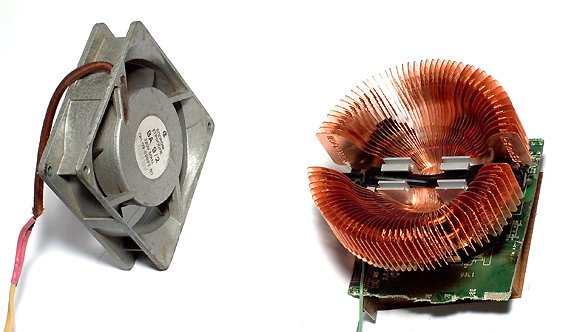 Readings are published on the next picture. Effect of the independent air flow on the heatsink temperature
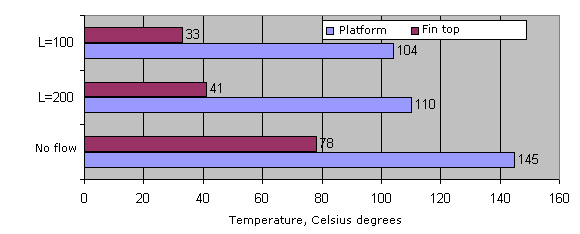 The initial platform temperature is 380°C, 143°C – with a heatsink, the middle vertical section is 85°C, the upper section is 76°C. On the whole it's a familiar picture. With enabled independent fan at L=200 mm the platform temperature dropped noticeably to 110°C, the upper section of vertical fins is 41°C. At L=100 mm these values are equal to 104°C and 33°C correspondingly. It's quite natural that the circumferential temperature nonuniformity of fins is 6°C already. Thus, such heatsinks are sensitive to any autonomous air flow. ConclusionWe are not going to generalize in this article. Particular conclusions have been already made above. In this article we've demonstrated the influence of a heatsink and a fan on the platform temperature for a single cooler type. We've also tried to combine aerodynamic and thermal tests. Such issues usually always go together in thermal devices. Of course, we shall try to perfect our testbed and measuring methods. We'll also try to collect more information on other coolers. The test method will also be improved in some measure. Noise characteristics will be dealt by professionals. This article is just a touchstone to look at the cooling issues from non-trivial angles. Write a comment below. No registration needed!
|
Platform · Video · Multimedia · Mobile · Other || About us & Privacy policy · Twitter · Facebook Copyright © Byrds Research & Publishing, Ltd., 1997–2011. All rights reserved. |